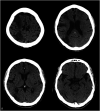Sequential Gaze-Shifting Approach to Reconstruct Self-portrait and Daily Activities in Hemispatial Neglect After Stroke: A Case Report
- PMID: 36865637
- PMCID: PMC9973291
- DOI: 10.1212/CPJ.0000000000200112
Sequential Gaze-Shifting Approach to Reconstruct Self-portrait and Daily Activities in Hemispatial Neglect After Stroke: A Case Report
Abstract
Objectives: The aim of this study was to demonstrate the use of a sequential gaze-shifting approach to complete a self-portrait in a patient with hemispatial neglect after stroke as a means of rehabilitation to restore skills to perform activities of daily living (ADL).
Methods: This case report describes a 71-year-old amateur painter who presented with severe left hemispatial neglect after stroke. Initially, he drew self-portraits omitting the left side. Six months poststroke, the patient was able to complete well-composed self-portraits by sequentially shifting his gaze and intentionally directing his visual attention from the right non-neglected space to the left neglected space. Then the patient was instructed to repeatedly practice a serial movement of each ADL using this sequential gaze-shifting technique.
Results: Seven months poststroke, the patient achieved independence in ADL such as dressing the upper body, grooming, eating, and toileting although moderate hemispatial neglect and hemiparesis were still present.
Discussion: The effects of existing rehabilitation approaches can be difficult to generalize and apply to the performance of each individual ADL in patients with hemispatial neglect after stroke. Sequential gaze shifting may be a viable compensation strategy in directing attention to the neglected space and restoring the ability to perform each ADL.
© 2023 American Academy of Neurology.
Figures



Similar articles
-
Gaze-contingent display technology can help to reduce the ipsilesional attention bias in hemispatial neglect following stroke.J Neuroeng Rehabil. 2022 Nov 16;19(1):125. doi: 10.1186/s12984-022-01104-5. J Neuroeng Rehabil. 2022. PMID: 36384816 Free PMC article.
-
Musical neglect training for chronic persistent left hemispatial neglect with right hemiplegia post-stroke: a case report.Front Rehabil Sci. 2025 Jan 7;5:1462978. doi: 10.3389/fresc.2024.1462978. eCollection 2024. Front Rehabil Sci. 2025. PMID: 39839741 Free PMC article.
-
Case Report: Visual Deprivation in Pusher Syndrome Complicated by Hemispatial Neglect After Basal Ganglia Stroke.Front Neurol. 2021 Sep 22;12:706611. doi: 10.3389/fneur.2021.706611. eCollection 2021. Front Neurol. 2021. PMID: 34630282 Free PMC article.
-
Effect of eye patching in rehabilitation of hemispatial neglect.Front Hum Neurosci. 2013 Sep 2;7:527. doi: 10.3389/fnhum.2013.00527. Front Hum Neurosci. 2013. PMID: 24032011 Free PMC article. Review.
-
Noninvasive brain stimulation in rehabilitation of hemispatial neglect after stroke.CNS Spectr. 2020 Feb;25(1):38-49. doi: 10.1017/S1092852918001748. CNS Spectr. 2020. PMID: 31046862
References
-
- Blanke O. I and me: self-portraiture in brain damage. In: Bogousslavsky J, Hennerici MG, eds. Front Neurol Neurosci–Neurological Disorders in Famous Artists Part 2: Karger; 2007:14-29. - PubMed
Publication types
LinkOut - more resources
Full Text Sources
